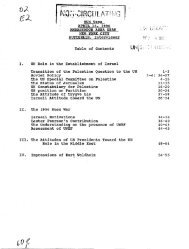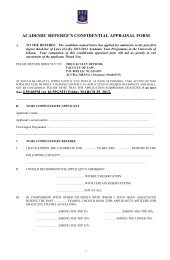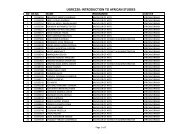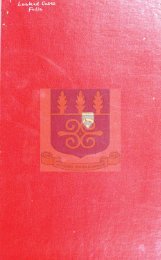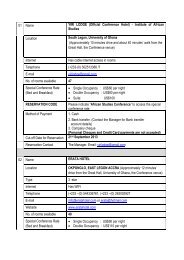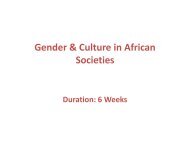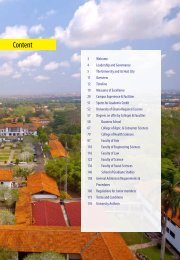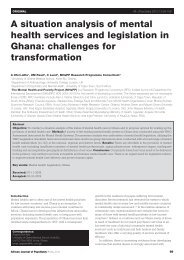AFRICAN ART, ITS PHILOSOPHY AND CRITICISM - Institute of ...
AFRICAN ART, ITS PHILOSOPHY AND CRITICISM - Institute of ...
AFRICAN ART, ITS PHILOSOPHY AND CRITICISM - Institute of ...
You also want an ePaper? Increase the reach of your titles
YUMPU automatically turns print PDFs into web optimized ePapers that Google loves.
Week 4. We’ll review the history <strong>of</strong> African art history -approaches to the subject and the methodologies applied -and pay particular attention to iconography, style, andaesthetics in African art. Special emphasis will be given toan examination <strong>of</strong> the development <strong>of</strong> “Mangbetu” art.We’ll go beyond fixed perceptions <strong>of</strong> African art andexamine its significance and contribution to internationaland global art. Challenges for contemporary artists will bediscussed in the tutorial.Week 5. The next three weeks will attempt to <strong>of</strong>fer abrief regional survey <strong>of</strong> prominent art forms within a fewmajor culture groups. Art is used extensively in visuallycreating and marking class and political distinctions,rituals and ceremonies. It helps establish politicalauthority and social controls. This week will coverexamples from North and West Africa. For North Africa,we’ll focus on old Egypt, or Kemet. In West Africa, we’lldiscuss Bamana arts, including sculpture, boli and CiWara masquerade; and leadership arts <strong>of</strong> the DahomeyKingdom, specifically appliqué cloths, bocio and largescalesculptures. In the tutorial we’ll explore dance andmasquerade as an art form in greater depth.Week 6. This week will cover examples from Centraland East Africa. We’ll begin with the historical KongoKingdom that established many <strong>of</strong> the leadership arts thatare followed today by related culture groups like theKuba. The influence <strong>of</strong> Christianity in the Kongo will beexamined, as well as, how Christianity intermingled withlocal beliefs to create new art forms. We’ll compare theking’s costume and royal textiles <strong>of</strong> the Kongo and Kuba.The royal Kuba masquerade trilogy will also be discussed.In East Africa, we’ll focus upon the Swahili Coast wheretrade with multiple groups from the interior and from theIndian Ocean led to a convergence <strong>of</strong> styles evident inmosques, housing, sculpture and textiles. In the tutorialwe’ll explore leadership arts in greater depth.Lecture:Drewal, Henry John. “African Art Studies Today”In African Art Studies: The State <strong>of</strong> the Discipline.pp. 29-62. Washington, DC: National Museum <strong>of</strong>African Art, 1990.Tutorial:Kasfir, Sidney. “Taste and Distaste: AfricaExplores: 20th Century African Art by Susan Vogel;Closeup: Lessons in the Art <strong>of</strong> Seeing AfricanSculpture by Jerry L. Thompson and Susan Vogel.”Exhibition Review. Transition 57 (1992): 52-70.Lecture:Visona, Monica Blackmun, Robin Poynor andHerbert M. Cole. A History <strong>of</strong> Art in Africa. 2nd ed.NY: Prentice Hall, 2008.Read about:Kemet/Egypt, pp. 44-56Bamana, a Mande group, pp. 104-105, 112-123Dahomey Kingdom, pp. 228-229, 256-264Tutorial:Thompson, Robert Farris. “African Art and Motion”In African Art In Motion: Icon and Act in theCollection <strong>of</strong> Katherine Coryton White. LosAngeles: University <strong>of</strong> California, 1979.Lecture:Visona, Monica Blackmun, Robin Poynor andHerbert M. Cole. A History <strong>of</strong> Art in Africa. 2nd ed.NY: Prentice Hall, 2008.Read about:Kongo Kingdom, pp. 350-363Kuba, pp. 381-392also pp. 395-397Swahili Coast, pp. 430-438Tutorial:Blier, Suzanne Preston. “Introduction: Paradoxes <strong>of</strong>Rule.” In The Royal Arts <strong>of</strong> Africa: The Majesty <strong>of</strong>Form. pp. 10-41. NY: Prentice Hall and Abrams,1998.
Week 7. This week will cover examples from SouthernAfrica, which has a unique and troubled history. We’llbegin with the mysterious stone structure known today asGreat Zimbabwe and then explore the arts <strong>of</strong> the Zulu andNdebele, both Nguni groups, living in South Africa. Theimpact <strong>of</strong> the Apartheid Regime as it is expressed visuallywill surface in Ndebele house painting and body arts aswell in contemporary art, including painting, sculpture,photography and video. Artists trained in the townshipsand those trained in academic institutions will becompared. In the tutorial we’ll explore two contemporarySouth African artists in greater depth.A review <strong>of</strong> this elective course for your exam will beprovided by the teaching assistant – date and time TBD.Lecture:Visona, Monica Blackmun, Robin Poynor andHerbert M. Cole. A History <strong>of</strong> Art in Africa. 2nd ed.NY: Prentice Hall, 2008.Read about:Shona and Great Zimbabwe, pp. 464-465, 471-478Zulu and Ndebele, Nguni groups, pp. 482-483, 485-489Art during and after Apartheid, pp. 492-497Tutorial:Godby, Michael and Sandra Klopper. “The Art <strong>of</strong>Willie Bester.” African Arts 29 (1 Winter 1996): 42-49, 104.Bick, Tenley, “Horror Histories: Apartheid and theAbject Body in the Work <strong>of</strong> Jane Alexander.African Arts 43 (4 Winter 2010): 30-41.
Additional sources for more information:Antubam K<strong>of</strong>i, 1963, Ghana’s Heritage <strong>of</strong> Culture. Leipzig: Koehler and Amelang.Cole, Herbert M. 1975, “The Art <strong>of</strong> Festival in Ghana.” African Arts, Vol. VIII, No. 3, pp. 12-23 & 60-62.Cole, H.M., and Ross, Doran H., 1977, The Arts <strong>of</strong> Ghana. Los Angeles: University <strong>of</strong> California.Elkins James and Newman Michael, 2008, The State <strong>of</strong> Art Criticism. New York: Routledge.Hackett I. J. Rosalind, 1996, Art and Religion in Africa. Cassell: London.Harris Jonathan, 2001, The New Art History: A Critical Introduction. London: Routledge.Kasfir Sidney, Littlefield, 2007, African Art and the Colonial Encounter. Bloomington: Indiana UP.__________________, 1999, Contemporary African Art. London: Thames and Hudson.Kyerematen, A. A. Y., 1964, Panoply Of Ghana: Ornamental Art in Ghanaian Tradition and Culture.NY: Frederick A. Praeger.Seiber, Roy, 1966, “Some Comments on Art and History in Africa,” Ghana Notes and Queries 8:6-8.Sieber, Roy, 1967, “African Art and Culture History” In Reconstructing African Culture History.Creighton Gabel and Norman Bennet, eds. Boston. Pp. 117-137.Sheppard, Anne, 1987, Aesthetics, An Introduction to Philosophy <strong>of</strong> Art. Oxford: Oxford University Press.Willet, Frank, 1971, African Art: An Introduction. New York: Thames and Hudson.African art journal published by The James S. Coleman African Studies Center, UCLA, will be <strong>of</strong>immense benefit to students to read.



